|
Falco Tempo Unlimited
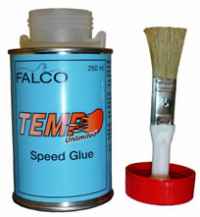 "The ITTF has recently announced that glues containing volatile organic compounds (VOCs) will be banned as of January 1, 2008, in ITTF junior events and as of September 1, 2008, in all other ITTF events (ITTF Announcement). "The ITTF has recently announced that glues containing volatile organic compounds (VOCs) will be banned as of January 1, 2008, in ITTF junior events and as of September 1, 2008, in all other ITTF events (ITTF Announcement). Falco Tempo Unlimited speed glue is the first VOC free glues on the market, and is much safer to use than other VOC based glues. Water-based VOC-free speed glue is now a reality! NOTE: This is a LONG LASTING speed glue, the effects are reported to last between 1 to 3 WEEKS!
Instructions for use (as described on the tin):
SHAKE WELL BEFORE USE. Put the glue on the rubber and the wood.
Apply one layer and wait 6 hours before applying a new layer. Let dry at least 24 hours in a dry place and at room temperature. Assemble the rubber and the blade. "
Warning: This product (and all other speed glues and alternatives) stretch the rubber, increasing the tension on the topsheet. Some high tension rubbers or Tensors are not designed to be used with speed glue or alternatives as it put too much tension on the topsheet. Some rubber are glued together better than others, so using speed glue or alternatives, there is always a risk of damage to the rubber.
Note: Unlike some of the other products that are starting to come onto the market, the Falco Tempo Unlimited is actually a glue, not a sponge treatment liquid that still requires glue to attach to the blade. It can be used on a new sheet of rubber, but can will even work quite effectively on a rubber that's been glued (normal or speed glue) before. This makes it unique, as I'm not aware of any other products on the market that have this property.
Review and description (by Alex):
1. Impression of the glue:
The tins are similar to the those used for other long lasting glues like Tibhar Rapid Clean Deluxe (RCD) and seals very well. The glue looks whitish and is quite thick, a little thicker compared to my Tibhar RCD. The smell is not very strong, and certainly does not have any organic solvent smell. It reminds me a little of the kids glue for gluing paper and stuff together.
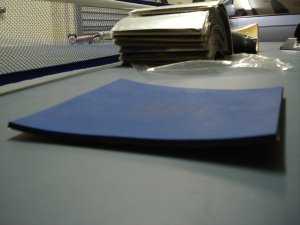 2. Testing the glue on a new rubber: 2. Testing the glue on a new rubber:
I figured the best way to test this glue was to test it on a rubber that I'm used to and know really. So the test are performed on a new sheet of Globe 999 National. Although normally before I speed glue a rubber I would prime it, but priming with normal glue or speed glue could affect the performance, so I decided not to prime, and accept that the performance may not be as good, or take a while for the rubber to peak...
Ok, here is a picture of the rubber unglued. Note it has a slight inwards dome. The plastic protection sheet is still on the rubber.
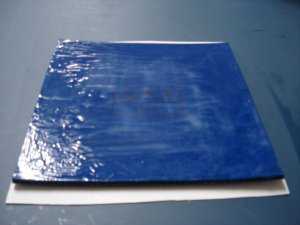 3. Applying the glue: 3. Applying the glue:
Ok, time to apply the glue. I shook the tin a little as recommend, and spread out a single brush-full of the glue over the sheet. I immediately noticed that I probably should have shook the bottle a lot more, since the white and transparent liquids had not mixed that well. I tried to mix it as well as I could on the rubber. You can see from the picture that some areas are still a little more whitish than other, but it's pretty good and hopefully won't affect the results too much. So NOTE: follow the instructions on the tin well, SHAKE before use!
4. After the first waiting period
 The instructions recommends a 6 hour period before the next layer. I decided to do 2 layers of glue, so that I could compare it to the 2 layers of Tibhar RCD glue that I normally use. I didn't get around to looking at the sheet until about 8 hours later, but this probably does not matter much since drying times were long anyway. So here is the sheet after 8 hours of drying: The instructions recommends a 6 hour period before the next layer. I decided to do 2 layers of glue, so that I could compare it to the 2 layers of Tibhar RCD glue that I normally use. I didn't get around to looking at the sheet until about 8 hours later, but this probably does not matter much since drying times were long anyway. So here is the sheet after 8 hours of drying:
The dome is quite good, at least as good as with my Tibhar RCD glue, so I was quite impressed so far. The surface looked dry and felt sticky.
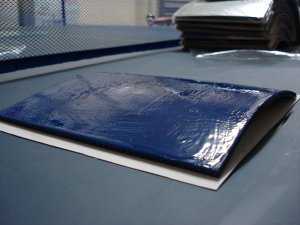 5. The second layer 5. The second layer
So I decided to put another layer on (as was the plan). I used a thinner layer this time since the dome was already pretty decent, but enough to wet the whole surface again.
Within minutes I could see the dome increasing again already. Since I was getting a little concerned to put too much stress on the topsheet with the plastic protection sheet still on, I decided to remove it. Well the dome increased by a fair more immediately, I was impressed! I started to wonder if the second coat may be necessary at all...
The sheet felt a lot more flexible already too, the initial stiffness of a new sheet seemed to have disappeared. Persumable this was due to the combination of stretching and the softening of the sponge.
In future I will remove the plastic protection sheet immediately, so that the topsheet can stretch with the sponge, putting less unnecessary tension on the bond between the topsheet and sponge.
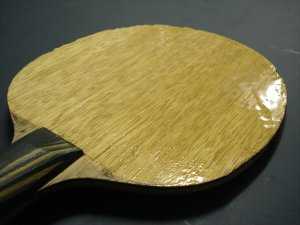 6. Apply glue onto the blade 6. Apply glue onto the blade
At this point I also needed to put glue on the blade, as it required up to 24h of drying before the rubber and blade should be put together. So I put a thin layer of the same glue on the blade....
Note: As discovered later (after a few more gluings), the glue can be applied about an hour before you're ready to put the rubber onto the bat, as drying time can be speeded up a lot with some airflow, like a fan... The actual drying time will depend on airflow, temperature and humidity.
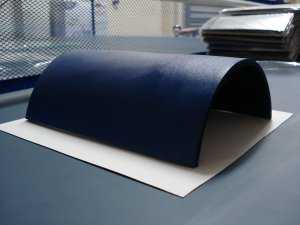 7. The next waiting period 7. The next waiting period Another 8 hours later, here is what the rubber looked like:
The dome had not changed much, perhaps slightly more, the 2nd thin layer may not have made a lot of difference as far as the done is concerned. The surface felt quite dry but very sticky.
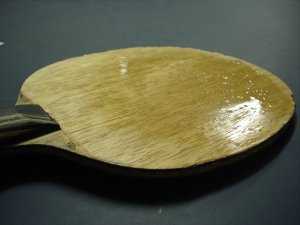 The blade has dried a little around the edges, but still seemed fairly wet in the middle. The part that had dried didn't really feel sticky very much but like with most contact glues, when the 2 surfaces are put together, the bond is very strong.
The blade has dried a little around the edges, but still seemed fairly wet in the middle. The part that had dried didn't really feel sticky very much but like with most contact glues, when the 2 surfaces are put together, the bond is very strong.
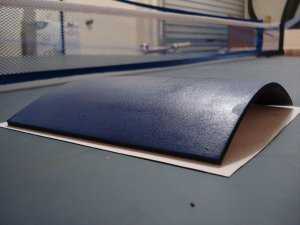 8. After the final waiting period 8. After the final waiting period Ok, the next morning, another 10 hours later or so I inspected the rubber and blade, and the dome had gone down a fair bit. As discovered later, this is normal for these types of glues.
There are 2 main reasons for this:
1. The topsheet is slowly stretching with the sponge, and after this time it's stretched significanty, making the doming effect less.
2. The glue has made the rubber more flexible and softer, so the sheet can no longer hold up the dome and has sagged down.
Of course this is unlikely to reduce performance, since the stretching of the rubber (topsheet AND sponge) is exactly what we want, to give improved speed performance. the softening of the rubber should improve the spin performance of this rubber.
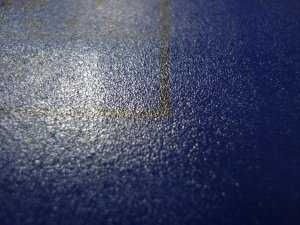 The sheet looks quite dry and is quite sticky as you might notice from the close-up. The sheet looks quite dry and is quite sticky as you might notice from the close-up.
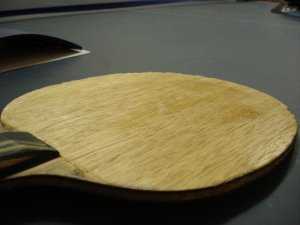 The blade surface has almost completely dried, and feels mildly sticky... as expected. In a few spots it still looks a little wet, but it feels thick and sticky so it should be OK. The weather has been cold and humid, so drying conditions are far from ideal.... The blade surface has almost completely dried, and feels mildly sticky... as expected. In a few spots it still looks a little wet, but it feels thick and sticky so it should be OK. The weather has been cold and humid, so drying conditions are far from ideal....
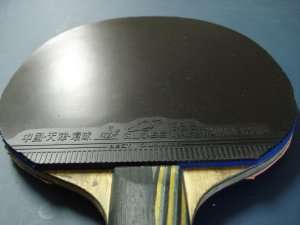 9. Time to assemble rubber and blade 9. Time to assemble rubber and blade Ok, time assemble the rubber and blade... I put the rubber onto the blade and rolled it with a roller as usual. It stuck down very well, no trouble at all. The topsheet looked in perfect condition, and was not affected in any way by the glue.
Feeling the rubber on the bat, the sponge definitely felt a little softer and more springy, but not as soft as my other rubber, which had been 'super primed' and had been glued about 4 times. I don't think it's a lot different to the first time I glue with my Tibhar RCD, it always takes a few gluing to soften it up...
10. The first test run.....
I compared it side by side with an identical rubber and blade, the other rubber had been 'super primed' and had been glued up with Tibhar RCD glue 4 times before, so this was well and truely 'worn in', which should be taken into account...
Well the rubber certainly had a decent speed glue effect. My loops were a fair bit faster, and definitely spinnier too. I don't think it was quite as fast as my other rubber, but not that far off. I could not feel the ball dig in as much as my other rubber, but I WAS getting very good spin. It felt like I was getting more spin from the topsheet... the feel was just a little different, but not hard to adjust to.
What I did notice also was that it was louder than my other rubber. These Globe 999 Nat rubbers are fairly firm, and my blade fairly soft, so there is not normally a lot of sound (I'm referring to the the speed glue clicky sound), but this rubber with the Falco glue was definitely louder than with my Tibhar glue. This could well impress other players with soft sponged rubber...
The rubber did not feel a lot different to a new sheet that was glued with my Tibhar glue for the first time... so this is very encouraging.
All in all I was quite happy, and I'm confident that this glue will do the job when I decide to stop using VOC glues. I find the Globe 999 Nat too hard to control without glue, as some softening of the sponge and a bit of a stretch is required, which is exactly what glue does. Well the Falco glue certainly does this, and hopefully will get even better over the next 1 or 2 gluings. As is normal with this glue, it does not peak until the 2nd or 3rd gluing, so performace will only improve from ehre on.
11. The next step
Next I will take the rubber off the blade and let it shrink back, and re-glue it again the next week (the effect will probably take a week to wear off), and see how it performs now that it's got some glue in the sponge, and has had a good stretch, which most Chinese rubbers require before they peak....
Priming the rubber with 1 or 2 thicker layers before use, and letting it have a good stretch, may well improve the performance as well, this is something else I'll have to investigate. If the performance of the rubber is significantly better the second time around, then priming is almost certainly the way to go.... The optimum priming method will need to be investigated too.
12. Conclusions after further experimentations and discussion
After experimenting a little more, and talking to other users of the glue, it is definitely a very effective speed glue. It is found more effective on softer sponged rubbers, since the softening effect of the Falco tempo Unlimited is not as great as VOC based speed glues. If further softening is required, the Falco Tempo Booster should be considered, which can be combined with the Unlimited for a huge speed glue effect.
***Note: One of a Kind Trading is the distributor for this products within Australia and New Zealand. If you are interested in becoming one of our distributors, please contact us for further information.
|





